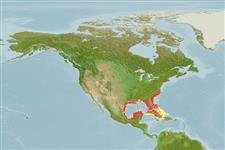Common names from other countries
Environment: milieu / climate zone / depth range / distribution range
Ecologia
; intervalo de profundidade 0 - 60 m (Ref. 114309). Tropical, preferred 25°C (Ref. 107945); 35°N - 18°N, 98°W - 71°W
Western Central Atlantic: from Mexico to Turks and Caicos, then Cape Lookout North Carolina south to Jamaica.
Length at first maturity / Tamanho / Peso / Idade
Maturity: Lm 6.6 range ? - ? cm
Carapace transversely oval, about 2.3 times as long as wide, convex, nearly smooth to unaided eye, minutely granulate and punctate; anterolateral margins (excluding outer orbital teeth) divided into 4 lobes, front (excluding inner orbital angles) with a median notch and a broad tri-lobate lobe on each side. Pincers large and heavy, unequal, nearly smooth; inside of hands with patch of fine, oblique, parallel striae; walking legs stout and hairy distally. Color: juveniles dark purplish blue, very young with legs banded cream and red and white spot on carpus of pincer. Older individual become dark brownish red to black or less mottled and spotted with dusky grey; fingers dark; walking legs with reddish and yellow bands.
Life cycle and mating behavior
Maturidade | Reprodução | Desova | Ovos | Fecundidade | Larvas
Ovigerous females are known from May to September.
Tavares, M. 2003. (Ref. 367)
Categoria na Lista Vermelha da IUCN (Ref. 130435: Version 2024-1)
Categoria CITES (Ref. 108899)
Not Evaluated
Not Evaluated
Utilização humana
Pescarias: espécies comerciais
FAO - pescarias: landings | FishSource | Sea Around Us
Ferramentas
Fontes da internet
Estimates based on models
Preferred temperature
(Ref.
115969): 23.5 - 28, mean 25.6 (based on 210 cells).
